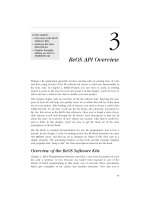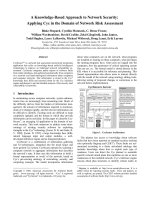The API Assessment Primer
Bạn đang xem bản rút gọn của tài liệu. Xem và tải ngay bản đầy đủ của tài liệu tại đây (1.12 MB, 49 trang )
The API Assessment Primer
Jason Haddix & Greg Patton
OWASP AppSecEU | May 21, 2015
Agenda
•
•
•
•
•
Introduction
Why API security matters
Assessment considerations
Common API vulnerabilities
Takeaways
2
About me
Greg Patton
SAST Manager, HP Fortify on Demand
• Manage the static analysis testing team for HP FoD
• Nearly ten years of DAST experience with web & mobile apps
• Attended my 1st OWASP meeting on June 7, 2007 (Houston,
TX)
3
Why API Security Matters
APIs are everywhere
• Mobile apps
• Internet of Things (IoT)
• Service Oriented
Architecture (soa)
• Enterprise thick-client
apps
5
API insecurity
• New surface area = dangerous surface area
• Many API developers haven’t had security training
• Many assume that because back ends aren’t visited by
end-users they are more secure (obscurity assumption)
6
API insecurity
Most APIs are vulnerable
– Analyzing any given API is likely to yield significant
vulnerabilities
– The newer, more eager the shop – the higher the chance of
issues
7
API Assessment Considerations
API testing approach
•
•
•
•
•
Acquire information
Map the API
Capture runtime traffic
Use automated scanners
Manually test, test, test
9
What to collect pre-assessment
Ask customer for
• Source code
– Static analysis & review
• Documentation
– Regular user
– Admin documentation
• Valid request data
– Known-good param values
– Order of function calls
10
Core toolset
Web proxy / HTTP editor
Network capture tools
• ZAP proxy
• BURP suite pro
• Wireshark
• Echo Mirage
Web service testing tools
Browser extensions
•
•
•
•
• Chrome: Advanced Rest Client
• Firefox: Hackbar
SoapUI
WSAttacker
HP WebInspect
Postman
11
API Mapping
Fully map the API, listing
all methods and functionality
at the start of an
assessment
Examine:
–
–
–
–
–
asmx
/help & help docs
WSDL (.NET)
WADL (Java)
Doxegen & help docs
– inurl:wsdl site:example.com
Explore
– runtime operations
12
API Mapping | Testing
Try different HTTP Methods
• Don’t assume other verbs won’t work
• May discover hidden functionality
13
API Mapping | Testing
Try different content types and executions
• JSON vs. XML vs. Text
• REST vs. XML
14
Common API Vulnerabilities
Common API Vulnerabilities
Broken Authentication &
Session Management
Information Leakage
Not-So-Hidden Functionality
Lack of Access Control
Tampering & Trust Flaws
Lack of Insecure Transport
Injection Flaws
Failure to Protect Keys
16
Authentication & Session | Concerns
• No authentication
• Insecure framework
implementation
– openID
– oAuth
•
•
•
•
Non-expiring session tokens
Weak password complexity
Lack of account lockout
Lack of logout/session expiration
mechanism
17
Authentication & Session | Testing
• Attempt to send requests with no
authentication
• Review authentication scheme
or framework
• Attempt to use simple
passwords
• Attempt to use old session
tokens
• Verify logout functionality truly
expires sessions
• Weak password complexity
• Attempt to lock account
18
Authentication & Session | Protections
• Require authentication
• Require strong password
• Use up-to-date
frameworks
– Latest version of oAuth,
etc.
• Ensure there is a way to
logout / expire sessions
• Pay special attention to
sensitive operations
• Use rate limiting to guard
again Brute Force abuse
19
Information Leakage | Concerns
Often APIs respond with
more data than required
• Apps returning all records
instead of only needed or
requested records
– Particularly common in
mobile applications
• Lack of data limiters
– No limits on the number of
requests a user can send
– Brute force all records
20
Information Leakage | Concerns
2014 RSA Mobile App - Exposed Personal Data
• App designed for connecting with conference activities,
viewing schedules, venue maps, etc.
• App used a web API to download information about
every registered user of the application
• />
21
Information Leakage | Testing
• Review API responses
– Do they return more data
than what was requested?
• Try wildcard values
– * , %, ?, space, etc.
• Review error messages
– Do they reveal technical
information?
– Do they reveal
enumeration flaws?
22
Information Leakage | Testing
23
Information Leakage | Protections
• Only return requested &
needed data
• Review responses for
sensitive information
• Review error messages
24
Hidden functionality | Concerns
API hidden functionality flaws are largely introduced due
to faulty developer assumptions, i.e. not thinking like an
attacker
• assume obscurity
• assume users will use functions only as intended
25









